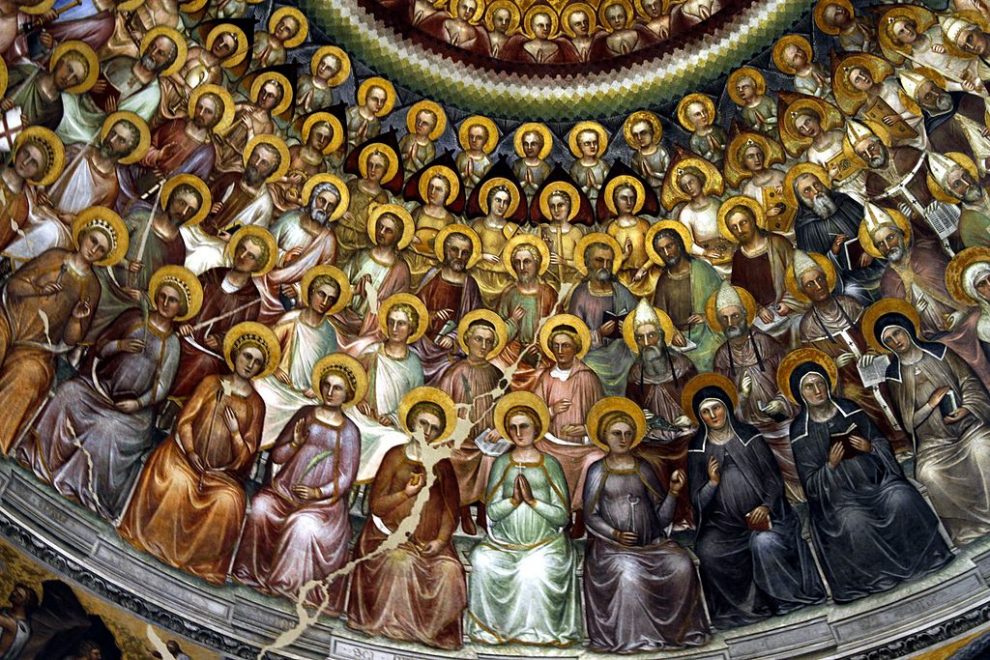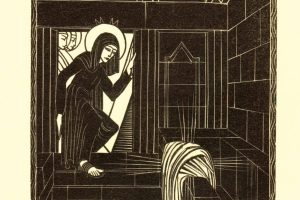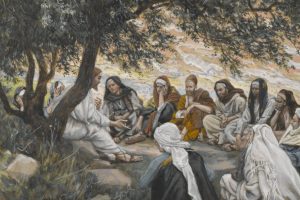A circle of women who gather for prayer remembers the names of Mary Magdalene, Joanna, and other women witnesses of Christ’s Resurrection, lamenting the suppression of these voices in the church but gaining strength to lift up their own voices now, regardless.
Before crossing onto a military installation to protest the arming of submarines with nuclear bombs, a group committed to peace pauses for prayer, calling upon Franz Jagerstatter to be present with them.
A roll call of Salvadoran martyrs read to the response of Presente! strengthens the commitment of a parish toward local activities for justice.
An Asian woman theologian welcomes a world assembly of Christian churches by calling upon the spirits of those unjustly dead—including among others Uriah, killed for David’s lust; the women burned as witches during the Inquisition; the Jewish victims of Nazi genocide; the earth, air, and water being poisoned by human greed; and last of all, the Liberator, our brother Jesus, tortured and killed on the cross—all enfolded in the life-giving power of the Holy Spirit.
In every instance, although not explicitly noticed or named, the traditional doctrine of the communion of saints is being brought to new, liberating expression.
The communion of saints is a Christian symbol that speaks of profound relationship. In traditional usage it points to an ongoing connection between the living and the dead, implying that the dead have found new life thanks to the merciful power of God. It also suggests a bond of companionship among living persons themselves who, though widely separated geographically, form one church community.
Since the range of those who seek God is as broad as the human race itself, it furthermore affirms a link between all who have been brushed with the fire of divine love and witness to this in their lives.
Insofar as the original Latin term communio sanctorum is ambiguous, referring in one instance to a communion of holy people but in another instance to a communion of holy things—it also signifies eucharistic sharing and, by extension, sharing in the sacred community of life that is creation itself.
From every angle the symbol of the communion of saints crosses boundaries, speaking to a communal participation in the gracious holiness of God. The public appearances of this symbol in creed and liturgy shed light on its basic meanings.
The fact of its inclusion in the creed signifies that the communion of saints is not immediately evident but a matter for faith. It nestles quietly between “the holy catholic church” and “the forgiveness of sins” and forms—along with “the resurrection of the body” and “life everlasting”—a sign of the compassionate presence and action of divine mystery in the world of life and death.
In liturgy the practical import of this symbol comes to the fore in the annual celebration of All Saints Day, that feast of splendid nobodies. While every eucharistic prayer remembers the great community of the dead “who have left this world in your friendship” and makes explicit mention of Mary, the apostles, martyrs, and all the saints, this feast spells out in a special way the challenge and hope of their memory.
In the first reading of the day’s liturgy, an awesome vision is evoked: a huge heavenly crowd, “which no one could count from every nation and race and people and tongue.” These are people who suffered, who knew sin and forgiveness and something of the laughter and tears of love, who gave a cup of cold water, who sought the face of God. Now they have died, passing beyond the veil to the place where “God will wipe away every tear from their eyes.”
The gospel proclaims that the road to joining this blessed company is the way of Jesus the Christ, crucified and risen, and entails being poor in spirit, merciful, pure of heart, peacemaking, and hungry and thirsty for righteousness. Accessed through memory and hope, the communion of saints can be believed only by being practiced in faithful deeds of discipleship.
Dialogue with history—in this case four examples of women’s practices of memory—gives us light to steer by as we explore a contemporary meaning of the communion of saints.
Hagar and the struggle to survive
The story of Hagar, recounted in the first book of Hebrew scripture (Gen. 16; 21:8–21) and used as an analogy in Christian scripture (Gal. 4:21–31), has long been overlooked in preaching and teaching because it does not fit neatly into themes of divine liberation and covenant.
It is no accident that contemporary recovery of her memory proceeds from the perspective of women who are poor, outsiders, and objects of repression even by other women.
Hagar is an Egyptian slave-woman far from home. Pressed into service as Sarah’s maid, she mothers Ishmael, Abraham’s first child. Twice she is driven into the desert by Sarah’s harsh abuse; the first time, God’s appearing to her leads her to return so that the child with whom she is pregnant will survive; the second time, near death, both she and her child are rescued with a divine word of promise for their future.
To her the voice of God pledges: “I will so greatly multiply your offspring that they cannot be counted for multitude,” and later, “Do not be afraid.”
The last we see of Hagar, she is finding a wife for her free and defiant son from among her own people, thus ensuring a burgeoning of divine promise in the continuity of her line. The ambiguity of divine blessing is obvious even here, however, as the biblical narrative identifies Sarah’s son Isaac as alone the bearer of the promise of the covenant.
Almost invariably, African American women’s haunting interpretations of this story evoke the painful history of race relations between black and white women.
Scripture scholar Renita Weems writes that “for black women, Hagar’s story is peculiarly familiar. It is as if we know it by heart. . . . The truth is, very few black women manage to make it through adulthood without a footlocker of hurtful memories of encounters with white women. . . . We must remember this story for its piercing portrayal of one woman’s exploitation of another woman.”
In and through all of this pain, theologian Delores Williams argues, the result of Hagar’s first encounter with God is precisely not liberation. The appalling instruction from the angel of the Lord to “return to your mistress and submit to her” indicates a strategy for sheer survival amid desperate circumstances: nothing more, but also nothing less.
In Hagar’s second encounter, God gives her new vision to see resources for survival where she had seen none before: a well of water in the desert for herself and her wailing, dying child to drink.
In both instances she was not rescued from her environment, as the Hebrew slaves were later to be liberated from Egypt. Rather, through encountering the Holy One she found ways to survive and create a future even as the oppressive situation persisted.
This example of Hagar illustrates one front on which women’s practices of memory are working. Hagar is certainly in the biblical text; her suffering is profound; her wits are keen; her encounters with the divine are groundbreaking. Yet the prevailing voice of interpretation has made her virtually invisible.
Recovering the lost memory of her creative striving to survive interrupts dominant discourse. It demands that the corporate memory of the church make room for the female, the foreigner, the one in servitude, the religious stranger—and the person who is all four—as a vital player in the history of humanity with God.
Bringing Hagar visibly into the cloud of witnesses lifts up a source of lament and resistance as well as strength and inspiration for all who remember her name.
Mary Magdalene: She’s not what you think
Recounted in all four canonical gospels and in later extra-biblical texts such as the “Gospel of Mary,” the contributions of Miriam of Magdala to the ministry of Jesus, her fidelity during his Crucifixion, and her leadership as first apostolic witness to the Resurrection place her in a pivotal role at the foundation of the church.
Yet centuries of patriarchal interpretation in literature, art, and preaching have depicted Magdalene primarily as a repentant sinner, most likely a prostitute, forgiven by Jesus for sins of a sexual nature.
There is an ethical issue here, for the distortion that shifts the story of a leading apostolic woman into someone remembered mainly as a sexual transgressor is a deep untruth. A powerful religious leader is turned into a beautiful, pliant sinner, symbol of female sexuality redeemed.
Like all lies, this robs her of the integrity of her own life. It cheats women out of the dangerous memory of her discipleship, leaving them bereft of a key piece of history on which to build resistance to ecclesial male dominance. And it deprives the church as a whole of the prophetic power of the memory of women’s leadership.
Rereading the texts, we see that Mary is among the band of Galilean women who leave their homes to follow Jesus in his itinerant ministry. Luke’s gospel describes the situation:
Soon afterwards he went on through city and villages, proclaiming and bringing the good news of the kingdom of God. The twelve were with him, as well as some women who had been cured of evil spirits and infirmities: Mary called Magdalene, from whom seven demons had gone out, and Joanna, the wife of Herod’s steward Chuza, and Susanna, and many others, who provided for them out of their resources (Luke 8:1–3).
In biblical usage the presence of evil spirits most often indicates that a person is ill, perhaps with epilepsy, more likely with mental illness. Mary Magdalene is evidently a woman in ill health whose interaction with Jesus issues in new vitality; she then joins his ministry as a faithful friend and influential, provident disciple.
The position of her name, always listed first among the women in Jesus’ company, suggests her leadership function.
Taken together, the biblical texts and later gnostic literature carry the memory of Mary Magdalene as a powerfully faithful disciple of Jesus and courageous witness to his life and destiny, a founding church mother, wise woman, revealer and teacher, interpreter of Jesus’ message in the early church, a woman friend of God.
How then, to cite theologian Jane Schaberg’s framing of the question, did the first apostolic witness become a whore?
Technically, it happened when male preachers and biblical interpreters combined the stories of several different women in the New Testament. In truth, there is no biblical story that depicts Mary Magdalene as a prostitute or any other kind of sinner, and none that shows her either anointing Jesus or being forgiven her sins. Yet various stories were coalesced under her name, with the result that by medieval times she becomes a sinner repenting her ways in the sex trade.
Feminist strategies of interpretation correct this distortion by bringing a different and clearly more authentic chronicle to light.
In essence, Miriam of Magdala is a first-century Jewish woman who acts in the power of the Spirit. A faithful disciple of Jesus during his ministry, first witness of the risen Christ, on fire with the Spirit of Pentecost, she is an apostolic leader who helps develop the gospel message and continues Jesus’ preaching once he is gone.
Correcting the distortion of the historical memory of Mary Magdalene, this “dear friend of God,” women find a companion whose memory cheers them with a dynamic flash of faithful friendship, spiritual insight, and self-confident leadership, and challenges them with a cautionary tale of how even the most outstanding witness can be bent by the pressures of patriarchal dominance.
The virgin martyrs: What was the point of their deaths?
A third example of women’s practices of memory takes us into subsequent centuries of persecution when women and men were put to a tortured death for the Christian witness. One subset of these martyrs honored by the early church comprises young women, girls really, who were also perceived as virgins: Agatha, Agnes, Lucy, Cecelia, Anastasia, and others.
Traditional ecclesial interpretation presents female physical virginity as a phenomenon of the highest spiritual value. To protect their virginity from contamination by marriage, usually to a Roman nobleman, these young women resist advances to the point where their intended husbands betray their stubborn Christian commitment to a magistrate, thus ensuring their death.
They are remembered because they defended their virginity and because they suffered for it. At least, that is how the stories have been told by the church for centuries, underscoring the values of virginity and suffering as ways of perfection for women.
The not-so-subtle message conveyed by this cache of stories is that women who exercise or enjoy their sexuality, or who do not suffer enough, belong on a plane of lesser holiness for precisely these reasons.
Placing these stories within the context of Roman society, however, brings to light the bold political nature of the acts of the virgin martyrs.
In addition to the standard patriarchal controls over women and their fertility, the need for a constant supply of young men to replenish its far-flung legions led Rome to demand that women marry and reproduce as a duty to the state. Marriage and the family were functions of the imperium.
In this context, these young women, deeply attracted to the Word of God, presume to have a life, a body, an identity apart from the patriarchal state’s definitions of what constitutes their humanity. Their refusal of marriage defies the conventions of “feminine” behavior, witnessing to a wild power of self-definition.
But why should death be the only option for women seeking self-definition? Holding this up as the ideal in all situations implicitly glorifies the torture and the murder while undermining women’s motivation to resist male predation. Here a counterargument begins to operate: The destruction of women through the ruination of their female bodiliness occurs too readily in the course of history and needs to be resisted.
The whole edifice of theological legitimation of suffering is at stake in this critique of unjust suffering known by women, by poor people, by victims of racial prejudice, by all those who feel the boot of the oppressor on their neck.
In alliance with the God of life, the church is called to resist rather than justify such suffering. If in the process life is taken, then the critical narrative of the struggle, far from promoting passivity, releases hope that energizes continuing resistance on the part of others. But terrible death need not be the only nor even the ideal road to salvation.
By contrast, as with Hagar, survival can be a holy choice. Living for the faith is as crucial a witness as dying for the faith. Resisting death is as much a way of holiness as is sacrificing one’s life.
The memory of the virgin martyrs as self-defining women on fire with the Spirit is put into context within the wider memory of women’s courageous and compassionate fight for survival for themselves and others.
Anonymous: Listening to the silent voices
Reference to the many unnamed women who have sustained life in the face of death illuminates a fourth example of women’s practices of memory.
These are women of every tongue and culture who bore and birthed, farmed and harvested, fetched and fed, cleaned and mended, taught and protected little ones, related to husbands, poured forth unending labor, pondered and prayed, sought their own space and exercised their wits in a patriarchal world, finding their connections to the sacred in the midst of myriad daily sufferings and joys.
Their circle is as wide as the Earth, including women from our own family trees and women of different races, classes, and ethnic cultures; women from the recent past and women long distant in time; struggling, poor, artistic, prophetic, quiet, shouting, funny, loving, suffering, self-defining, seeking, defiant, scared, subtle, sexy, gutsy women of all ages.
Here we do not search out the singularly heroic. While most women have not been simply male appendages, neither have they been elite women who are exceptions to the rule, outstanding for their public contributions such as fighting against multiple obstacles for their oppressed people.
Instead, as Adrienne Rich points out, in seeking strength from our heritage we need to look above all for the greatness and sanity of ordinary women and how, day in and day out, these women collectively waged resistance.
“In searching that territory,” Rich writes, “we find something better than individual heroines: the astonishing continuity of women’s imagination of survival, persisting through the great and little deaths of daily life.”
Companions in memory
Recognizing the play of grace in the lives of other women, women gain a more anchored appreciation of their own blessedness. Conversely, acknowledging themselves to be sacred, in the very image of God, women become empowered to name and celebrate the holiness of other women.
This experience offers a model for retrieving the communion of saints not as a static doctrine but as a dynamic symbol of the company of friends of God and prophets, thanks to the life-giving work of the Spirit. Rich connection to the past functions as a source of religious energy for struggle now and also as a pointer to a different future in view of God’s promise, tested and witnessed to in so many lives.
The communion of saints is a most relational symbol. From age to age, the same Spirit who gives life to and renews the natural world enters into holy souls, and not so holy ones, and makes them friends of God and prophets. Guided by this core vision, we seek to understand the fullness of relationship the communion of saints means to convey by breaking down the symbol into five basic elements:
1. All saints
In the first place, the communion of saints comprises all living persons of truth and love.
The point to emphasize is all: all Christians as well as all persons of good will. While the term itself springs from the experience of grace within the church, the communion of saints does not limit divine blessing to its own circle. Within human cultures everywhere, the Spirit calls every human being to fidelity and love, awakening knowledge of the truth and inspiring deeds of compassion and justice.
Too often theology has squeezed this meaning dry, eliminating first those who are not baptized and then most of the baptized themselves. Recovering a sense of the holiness of the ordinary person is a first step in unleashing the symbol to its full, comprehensive scope.
2. Everyday saints
The arena where holiness flourishes is everyday life, which itself has a sacred character.
The term heroic sanctity, used in official church language as a criterion for those whose cases are tested for canonization, reflects a value given to a certain kind of spiritual achievement, attained by intrepid acts and buttressed by miracles. It customarily points to such deeds as witnessing to the point of bloody martyrdom, engaging in the martyrdom of stringent asceticism, experiencing a radical conversion from which one does not turn back, renouncing family and worldly possessions, or pouring out lifelong dedication to the sick, the poor, the imprisoned.
Traditional “lives of the saints” are filled with such titanic acts. Noble they may be, but their telling within a tradition of holiness interpreted along lines of hierarchical dualism serves to reinforce the “unsaintliness” of those who do not measure up to these epic proportions.
Reading the communion of saints as a company of the friends of God and prophets reclaims the ordinary milieu of virtue and the nobility of struggle despite failure and defeat, locating holiness not only or even chiefly in mighty, ideal deeds but in creative fidelity in the midst of everyday life.
3. Witnesses through time
The communion of saints is not restricted to persons who live and breathe at the present moment, but embraces those who have gone through the shattering of death into eternal life.
Only the hope that God is trustworthy can ground this interpretation, for death truly ends life as we know it. What follows is unimaginable, and no pictorial description of saints in heaven is ever remotely adequate.
As theologian George Tavard has succinctly written, this “is not the fruit of works or the reward of individual merit, but it is entirely God’s gift. All the faithful on earth are saints in the biblical sense of the term. All those who die in Christ are saints in heaven.” And both groups are linked by their communion with the living God who pervades and transcends the boundaries of time itself.
The company of saints in heaven beggars description. While some few are remembered by name, it enfolds millions upon anonymous millions of people whom we will never know.
In different times and places their imagination and initiatives brought compassion alive in their own corner of life and comforted, healed, and challenged the world in ways that we can never imagine. “By passing along the narrow road they widened it, and while they went along, trampling on the rough ways, they went ahead of us,” as Augustine preached.
Among these saints, known and mostly unknown, are counted those untimely dead, killed in godforsaken incidents of terror, war, and mass death, their life’s projects cut down in mid-stride. Having drunk so deeply of the cup of crucifixion, they call forth special mention in anguish and lament.
Among these saints are also numbered some whom we knew personally. Their number increases as we get older: grandparents, mother and father, sisters and brothers, beloved spouses and life partners, children, teachers, students, patients, clients, friends and colleagues, relatives and neighbors, spiritual guides and religious leaders.
To say of all these people that they form with us the company of the redeemed is to give grief a direction, affirming that in the dialogue between God and the human race the last word is the gracious word of life.
In instances where persons have wrought real and lasting damage by their actions, faith holds out the possibility that at their deepest core they did not concur in diabolical evil. The church’s prayer is that God will be more merciful toward them than they have been to others. On their behalf, at least we may hope.
Saints on earth have access to the company of saints in heaven through memory and hope.
Memory is meant here in the sense of anamnesis, an effective remembering that makes something genuinely past to be present and active in the community today. A remembered event becomes a living force in history when it is recalled and narrated; in the very retelling, power comes forth to change the horizon of our days and offer new possibilities of existence.
Retelling their story brings the subversive, encouraging, and liberating power of their love and witness into the present generation.
4. Canonized saints and holy role models
Within this great cloud of witnesses, different times and places will see the emergence of particular persons who focus the energies of the Spirit for a local community in its own unique circumstances.
When these persons are recognized by the common spiritual sense of the community, they become publicly significant for the lives of others. These are the people traditionally and all too narrowly called saints in the customary parlance of Christian tradition.
Using this sense of the term, Lawrence Cunningham’s definition captures this element of the communion of saints well: “A saint is a person so grasped by a religious vision that it becomes central to his or her life in a way that radically changes the person and leads others to glimpse the value of that vision.”
Theologically these particular persons have no essential spiritual advantage over the rest of their community who are saints in the biblical sense. All are touched by the fire of the Spirit and called to a life of prophecy and friendship with God, which renders holiness a general and constant phenomenon in the sinful church.
Canonized or not, their names are remembered as a benediction, as an act of resistance, as a call to action, as a spur to fidelity.
In addition to persons involved in the life and ministry of Jesus and the beginnings of the church, and in addition to the early martyrs, each age including the present one knows such persons: “The fountain is still flowing, it hasn’t dried up,” says Augustine.
5. All creation
The communion of saints has traditionally focused on humans and their companionship in the Spirit throughout space and time. As scientific discovery and ecological concern reposition the human race in relation to the natural world, however, the realization dawns that the greatest community of all is the world itself, which has spawned the human race and which sustains its life every moment.
In a physical and biological sense, interrelationship is not an appendage to the natural order but its very lifeblood. Everything is connected to everything else, and it all flourishes or withers together.
In a theological sense, the same divine creativity that fuels the vitality of all creation also lights the fire of the saint. The communion of holy people is intrinsically connected to the community of holy creation, and they stand or fall together.
Friends for all time
The discovery of the communion of saints as an inclusive community of friends of God and prophets in contrast to a spiritual hierarchy of patrons and petitioners creates a foundational shift in the symbol’s theological interpretation. From this flow several other key interpretive changes:
- from emphasis on the dead alone to the whole living community as all saints;
- from emphasis on heroic virtue and the miraculous to everyday struggle and creative fidelity;
- from canonized saints alone to the whole company of the dead, embraced in the life of God and accessed through memory and hope;
- from holy figures as elite practitioners of virtue to those same persons as comrades cherished for their witness and the encouragement it gives;
- and from a purely human-centered circle to a community of the whole natural world imbued with God’s blessing.
Together the living form with the dead one community of memory and hope, a holy people touched with the fire of the Spirit, summoned to go forth as companions bringing the face of divine compassion into everyday life and the great struggles of history, wrestling with evil, and delighting even now when fragments of justice, peace, and healing gain however small a foothold.
When they are seen together with the whole natural world as a dynamic, sacred community of the most amazing richness and complexity, then the symbol of the communion of saints reaches its fullness as a symbol of effective presence and action of Holy Wisdom herself.
This article appeared in the November 1999 issue of U.S. Catholic magazine (Vol. 64, No. 11, pg. 12-18).
Image: Wikimedia Commons














Add comment